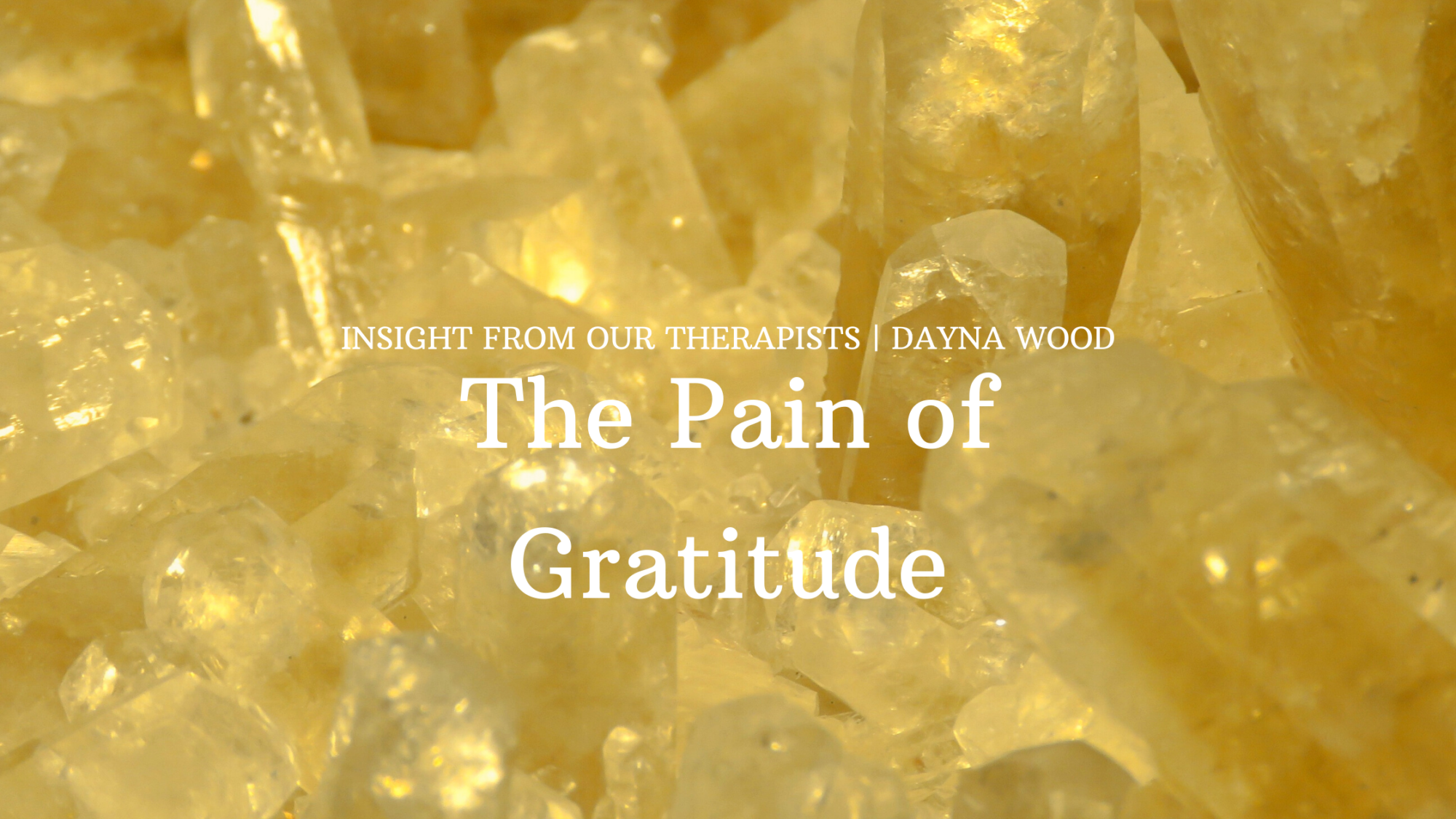Welcome to the heartbeat of Integrative Counsel, our blog where tranquility meets transformation. This is your sanctuary for insights and wisdom on nurturing a harmonious connection between mind, body, and spirit.
The Pain of Gratitude

There is something fundamentally challenging about gratitude that goes beyond remembering to practice it. If I truly admit how damn fortunate I am, I usually experience a myriad of feelings: pure love, then guilt, and then sheer terror.
Guilt and terror? That might surprise you. After all, we practice gratitude to help us become more positive and serene, and more appreciative of the good things in our lives. But sometimes, when I’m thinking about how grateful I am for the people, places and things in my life, I can become paralyzed by the thought of all of it just…vanishing. And that’s a terrifying thought indeed.
I don’t believe this stems from a fear of abandonment, or an attachment disorder issue. Rather, it comes from a deep understanding that everything is temporary. My four-year old daughter, jumping up and down naked on the bed, laughing with pure glee, will soon be a memory. My almost-seventeen-year-old cat, who likes to snuggle in the mornings, will also be gone. As will my partner someday.
So, the question becomes: how do I allow myself to fully open and experience the absolute love and gratitude that abounds in these moments, while also fully comprehending that it will never be the same again?
This is not a rhetorical, philosophical question. Really, how do we receive and embrace the good, when we know it can’t last?
I’m reminded of a Carl Jung quote regarding dichotomy (the division between two mutually exclusive or contradictory situations): “But there is no energy unless there is a tension of opposites…”
When I practice tools that help me become more comfortable with dichotomy, I’m better able to sit with this tension without reacting. These reactions typically take the form of any number of distractions and unproductive behavior, including negativity.
While our brains are wired for negativity and, as I mentioned in a previous post, it kept our ancestors alive, we now know we can actually rewire our brains. Ironically, gratitude is one of the best ways to accomplish this. (See Rick Hanson’s work for more on the brain’s negativity bias).
However, if the experience of gratitude can be painful, then where does that leave us?
There are a few mind/brain hacks you can use to hold dichotomy or, as I call it, brain integration. To give an oversimplified description, our brains have two hemispheres, the left and the right, and they quite literally understand the world differently. The left hemisphere sees things in black and white, yes or no, one way or the other. But the right hemisphere allows for a multitude of shades and colors. It can tolerate the tension of division, and can begin to detect webs, or patterns, that are impossible to see when viewed only in a linear fashion (e.g., yes/no, right/wrong, good/bad, etc.).
So how do we facilitate the integration of these two parts of our brains? Well, we have to start by flexing the hemisphere that is most atrophied, which is – unsurprisingly – the right hemisphere. When we have an awareness that these right-brain experiences are 1. available, and 2. valuable, we can bring back the subtle, yet powerful, knowledge of the right hemisphere into our everyday experiences.
How do we begin to “listen” to the vast amount of information offered to us from the right-hemisphere?
First, we have to listen in a different way, as the messages we receive will “sound” different from what we’re used to. For instance, our bodies speak volumes and are directly connected to the right hemisphere. We can start to become aware of the ways our bodies “talk” to us. You might feel queasy when you’re about to give a presentation at work. Or you get goosebumps when watching a scary movie.
Our intuition is also talking to us all the time. Intuition has gotten a bad rap over the years, with many people feeling it’s “airy fairy” or “woo-woo”. However, our intuition is actually “the ability to understand something immediately”. It’s a sense of knowing. And it’s the way the right hemisphere works: by instantly taking in and comprehending the whole picture. Think about the feeling you get when you know someone is lying to you. You might not have proof, but you just know. Or when you get a really good “feeling” about an interview candidate. Eureka moments are possible in this state!
I’m not suggesting that analysis and mental dissection, which are classic left-hemisphere attributes, are not valuable. They absolutely are. However, we tend to get “stuck” in this way of knowing without allowing or acknowledging input from the right hemisphere. As a result, we miss out on the opportunity to understand the situation from a different perspective; one in which the whole (or gestalt) can be understood.
The right hemisphere doesn’t use everyday language (which is housed in the left hemisphere) to communicate. It usually “speaks” without words – you get a gut feeling, or an image or diagram pops into your head seemingly out of nowhere. So, we have to listen in different ways:
- Making art
- Creativity (crafting, cooking, gardening, etc.)
- Spending time in nature
- Stepping back to see the whole picture – what I call “zooming out”
- Being embodied (practicing yoga, dancing, etc.)
- Listening to music
These are just a few ways you can practice tuning into your brain’s right hemisphere.
Bringing this information into our daily lives does take a certain amount of trust. However, when we begin to consciously listen and make the effort to become familiar with what might at first feel very foreign, uncomfortable, and maybe even undefined or wishy-washy, and then implement this knowledge, more will follow.
The right brain can become a storehouse of valuable wisdom. And, it can be really fun (humor and wit are also right-brain attributes!). With a bit of practice, we can become more familiar and comfortable with the opaque and the dichotomous. And getting comfortable operating from this place can feel like coming home.
Ultimately, we’ll be able to more easily manage the sometimes terrifying feelings that can come up when practicing gratitude. And that’s something we can be truly thankful for.
Sign up to receive our virtual magazine in your inbox! We send free resources, art and journal prompts, wisdom from our practitioners, and more. Click here to get on the mailing list.
Dayna Wood is the founder of Integrative Counsel; at Integrative Counsel, we offer an eclectic style of treatment that integrates the mind, body, and transpersonal. Our “special sauce” combines creative, out-of-the-box thinking with solid scientific research so our clients get the best of both worlds. Our team of experienced counselors has specialized knowledge in relationships, trauma, OCD, and other expansive therapies – aiding people in uncovering deep-rooted emotions and beliefs that remain the cause of present-day symptoms so they can experience more persistent breakthroughs. We understand that mental health is more than just its symptoms!
October 21, 2016
Click here to book a consultation call and start navigating your personal path to mental harmony with a therapist who gets you. Your journey, your pace, your story—let's unfold it together.
Let's keep the conversation going.
Feeling the spark to light up your wellness journey?
resources
CONTACT
RATES
join us
shop
SERVICES
OUR APPROACH
visiting professionals
OUR TEAM
HOME
727.342.0054
hello@integrativecounsel.com
Integrative Counsel is committed to providing culturally competent services. We respect the uniqueness of every person including, but not limited to race, ethnicity, gender identity, sexual orientation, class and religious affiliation.
